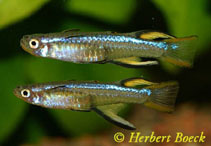| Family: |
Pseudomugilidae (Blue eyes) |
| Max. size: |
3.5 cm TL (male/unsexed) |
| Environment: |
pelagic-neritic; brackish; marine |
| Distribution: |
Western Pacific: northern Australia, near Broome and between Darwin and Wyndham, Northern Territory. |
| Diagnosis: |
Dorsal spines (total): 3-5; Dorsal soft rays (total): 4-7; Anal spines: 1-1; Anal soft rays: 9-13. Premaxilla wide, its ascending process short and lateral process absent. Vomer wide and slightly curved. Mesethmoid absent. Second dorsal fin with no spines and 4-7 soft rays. Pectoral fins with no spines. Midlateral scales 22-26. Elongated rays and base of second dorsal fin black. |
| Biology: |
Inhabits mangrove swamps and highly saline creeks flowing into estuaries, usually swimming over muddy bottom. Often congregate in large numbers. May be found in hypersaline waters (28-40 ppt) and in relatively high temperatures (22-31°C). Breeding has been achieved in aquaria; the eggs take about two weeks to hatch and young fish reach adulthood in only three months (Ref. 44894). A small but attractive species. |
| IUCN Red List Status: |
Not Evaluated (N.E.) Ref. (130435)
|
| Threat to humans: |
harmless |
Source and more info: www.fishbase.org. For personal, classroom, and other internal use only. Not for publication.
